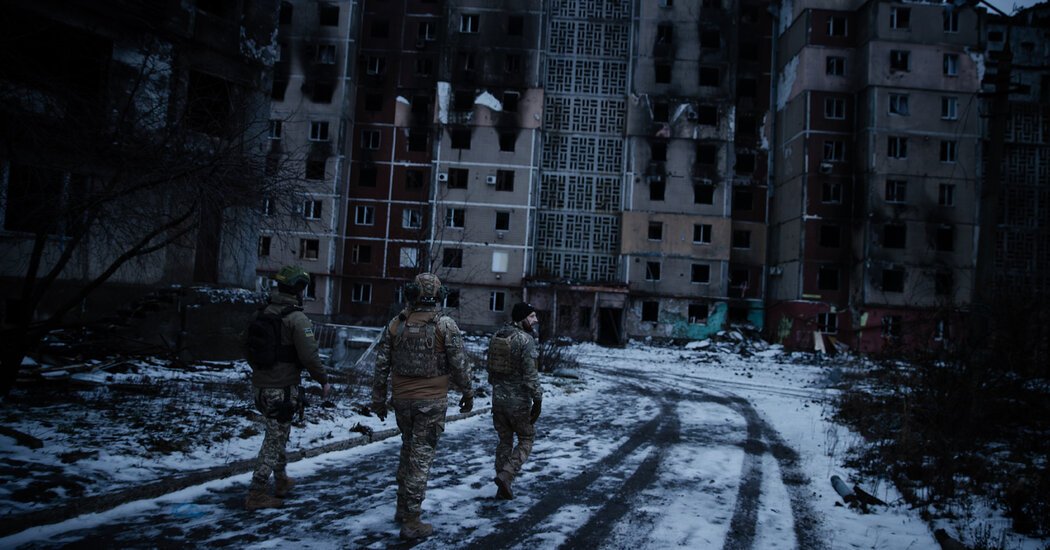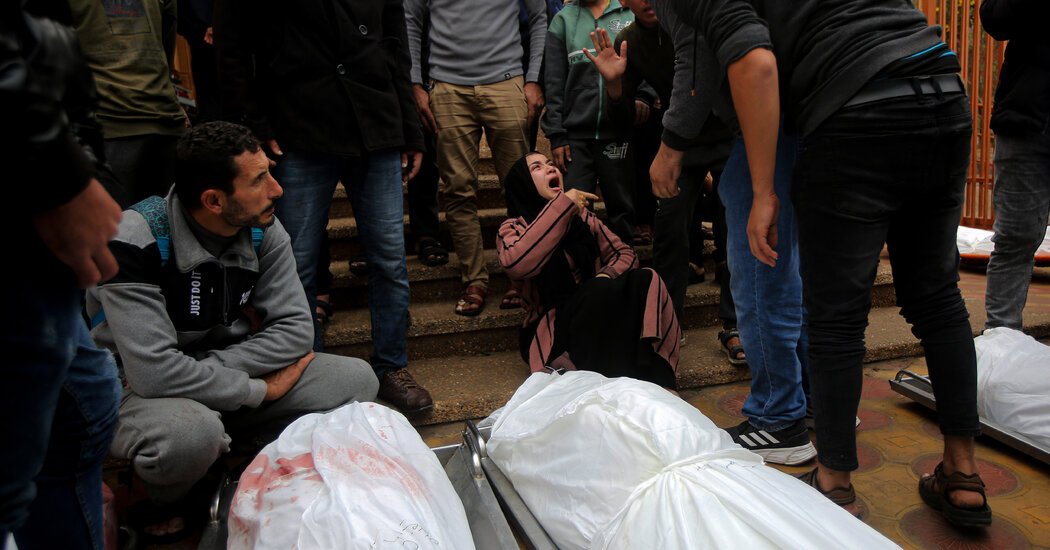His unit decimated by Ukrainian fire, the last surviving soldier in a Russian assault took cover in a shallow crater while Ukrainians shouted at him to surrender. As he lifted two grenades in the air, a Ukrainian drone swept in from above and exploded.
Soon, the smoke cleared, a surveillance drone overhead showed, revealing the Russian soldier’s corpse. That day’s attack, just north of the destroyed city of Avdiivka, was repelled. But the Ukrainians were under no illusions: There would be many more.
“They come in waves,” said Lt. Oleksandr Shyrshyn, 29, the deputy battalion commander in the 47th Mechanized Brigade. “And they do not stop.”
As the war enters its third year, Ukrainians find themselves outmanned and outgunned. After dominating the fighting in the first year and battling mostly to a standstill in the second, they have relinquished the momentum to Russia. Now they are digging in and fighting to hold on.
Mortar crews need to ration artillery shells. Troops are being rotated from units in the rear to join undermanned infantry units at the front, and there are shortages of critical supplies needed to repair and maintain Ukraine’s armored vehicles.
Because the Ukrainians are critically short of ammunition, for instance, they cannot afford to fire at only one or two advancing enemy soldiers, so the Russians have adapted and often move in small numbers to their most forward positions. They try to amass enough soldiers to storm a Ukrainian trench and overwhelm the defenders.
“Now, we don’t have enough equipment, enough people to go on the offensive,” Lieutenant Shyrshyn said. “So the main goal, for now, is to hold the position we have.”
Kyiv recently announced the allocation of nearly $500 million to build fortifications along its border with Russia and to create a deeper defensive line in the eastern Donbas region that can serve as fallback positions should the Russians achieve a major breakthrough.
The epicenter of the fighting remains around Avdiivka in the eastern Donetsk region, where the Russians have staged relentless assaults, no matter the obstacles. They spent weeks fighting for control of an industrial slag heap on the outskirts of the city, sending waves of troops up only to be cut down in horrifying fusillades. They creep through tunnels under the city streets and direct unmanned vehicles packed with explosives at Ukrainian positions.
It is all in the pursuit of another annihilated city. But their attacks in Avdiivka and elsewhere along the front serve a larger goal: to seize the advantage at a time American military support to Ukraine has ceased, and to overwhelm the Ukrainians with sheer mass.
While they are now almost exclusively engaged in defensive operations, Ukrainian soldiers interviewed along the front said that did not mean they could simply hunker down. They are seeking to inflict maximum pain on Russian forces while avoiding prolonged battles that could result in their own steep losses.
For the moment, Russian forces are achieving only marginal gains despite pouring enormous amounts of resources into their winter offensive.
Last month, journalists from The New York Times were able to watch several recent battles with commanders and drone operators around Avdiivka and another ruined city, Vuhledar — two key hot spots on the eastern front. The scope of the Russian losses was evident in the fields of ruined armor and the broken bodies of soldiers littering snow covered fields.
The Ukrainians are using mines and other obstacles to channel Russian armor into kill zones, where they can be hit with heavy guns nearly every time they mount an armored assault. They are aggressively using Western-supplied fighting vehicles and tanks as hunter-killers when Russian troops get close to the Ukrainian positions.
Since the Russians are now able to fire five times as many shells as the Ukrainians in some parts of the front, according to artillery units working on the front, the Ukrainians have had to increasingly turn to bomb-laden drones piloted remotely, known as FPVs, to try to plug the gap.
But the Ukrainian firepower is still limited. Major Serhii Bets, 30, the chief of staff of the 48th Separate Rifle Battalion of the 72nd Mechanized Brigade, said that the drones were an effective tool but could not be compared with the big guns.
“A first-person drone will not disassemble the dugout, will not mow the tree line,” he said. “It does not exert such psychological pressure on the enemy. And we don’t have a lot of FPV crews”
The Russians also still dominate the skies and, after a brief pause following the downing of several Russian fighter jets, the aerial bombardments have resumed, soldiers said.
Scores of giant craters left by 1,000-pound bombs in annihilated villages testify to the destructive force that Russia continues to bring to bear.
While it is unclear how long Kyiv can sustain its defense if its Western allies do not continue to provide robust military support, Ukrainian forces continue to inflict heavy damage on Russian forces while mostly holding the line.
Since Russia began renewed offensive operations in October, it has lost 365 main battle tanks and some 700 armored vehicles, “but only achieved minor territorial gains,” the British military intelligence agency said last Monday.
More than 13,000 Russian soldiers were killed and wounded in only two months of operations aimed at capturing Avdiivka, according to a declassified American intelligence assessment released in December. That works out to about 3,000 Russian casualties for every square mile of territorial gains.
Still, the British intelligence agency warned that Russia would most likely be able to “continue this level of offensive activity for the foreseeable future.”
“If the Russians are interested in a particular section of the front, they will raze it to the ground,” said Major Bets of the rifle battalion, pointing to a screen showing live drone footage to illustrate his point.
“Since mid-December, the Russians have completely destroyed this tree line,” he said. “If you look around the tree line in a radius of 100 by 100, there is just plowed land.” But, he said, Ukrainian defenders are “digging holes to live somehow, holding on.”
Still, even small Russian gains pose risks for Ukraine. The capture of Marinka — a town near Avdiivka outside the city of Donetsk — after years of fighting has allowed the Russians to open up a new line of attack on another town, Vuhledar, from the north.
“The enemy has partially succeeded,” Major Bets said. “We will not hide it.”
They use their advantage in artillery to “disorient our guys in the trenches, and then the infantry comes,” he said. “We are fighting against the infantry calmly and holding our ground.”
”
It is no secret that the Kremlin’s strategy is to outlast the Ukrainians, and its forces are keenly aware of Ukrainian artillery shortages, soldiers said, repeatedly adjusting tactics to try to gain an advantage.
As cannon fire thundered above ground last week in Avdiivka, more than 150 Russians crept through a narrow pipe underground to an important Ukrainian fortified position in a recreational facility called “The Tsar’s Hut.”
They emerged behind the Ukrainians and ambushed them, according to both sides. At a campaign event on Wednesday, President Vladimir V. Putin, who is running for re-election, appeared to cite the operation as evidence of success on the battlefield, saying Russian soldiers “seized 19 houses and are holding them.”
As supplies and ammunition dwindle, Ukrainians said they would have to pay a higher price in blood to simply hold their lines.
Lt. Serhii Stetsenko, 40, a commander of an assault platoon, said that even if the Russians only manage to claw their way forward a few feet, they dig in and fortify.
They will often leave only two or three soldiers at these new forward positions. “They call them camels,” he said, using a slang term for people who do tedious work while being treated like animals.
Those soldiers can spend several days digging, while another group assembles before starting another storming operation, he said.
Sgt. Danylo, the commander of an air reconnaissance unit for the 47th who asked that his surname not be used for security reasons, said that if the defense is working well, they will break up an attack before it can get fully underway.
“Defensive operations are much more controlled,” Sergeant Danylo said during an interview at an outpost near Avdiivka. “You are setting the conditions for the ground you control.”
But in battle, things can quickly spiral out of control.
Lt. Stetsenko described one recent clash when a Russian tank managed to make it to their position.
“The tank destroys everything in its path, so you won’t even stick your head out,” he said. “They jump out of the vehicles and rush into the trenches, destroying everything in front of them. Guys who surrendered, they shot them all.”
Major Bets likened the confrontations to a boxing match. “The main thing is the ability to take a punch,” he said. “I can proudly tell the whole world that Ukraine knows how to take a punch. But this is not the last round.”
Liubov Sholudko and Anastasia Kuznietsova contributed reporting.





